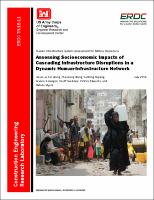Please use this identifier to cite or link to this item:
https://hdl.handle.net/11681/20251| Title: | Assessing socioeconomic impacts of cascading infrastructure disruptions in a dynamic human-infrastructure network |
| Authors: | Tweddale, Scott A. (Scott Allen) Edwards, Patrick L. Myers, Natalie R. D. Roningen, Jeanne Marie Lu, Liqun Ouyang, Yanfeng Wang, Xin Wang, Zhaodong |
| Keywords: | Sociology, Military Infrastructure (Economics)--Mathematical models Cities and towns Natural disasters Emergency management War |
| Publisher: | United States. Office of the Assistant Secretary of the Army for Acquisition, Logistics, and Technology. United States. Army. Corps of Engineers. Engineer Research and Development Center (U.S.) Construction Engineering Research Laboratory (U.S.) Cold Regions Research and Engineering Laboratory (U.S.) Human Infrastructure System Assessment for Military Operations Program (U.S.) |
| Series/Report no.: | ERDC ; TR-16-11 |
| Description: | Abstract: he functionality of modern cities relies heavily on interdependent infrastructure systems such as those for water, power, and transportation. Disruptions often propagate within and across physical infrastructure networks and result in catastrophic consequences. The reaction of communities to disasters (e.g., seeking alternatives) may further transfer and aggravate the burden on surviving infrastructures, which may facilitate cascading secondary disruptions. Hence, a holistic analysis framework that integrates infrastructure interdependencies and community behaviors is needed to evaluate a city’s vulnerability to disruptions and to assess the impact of a disaster. U.S. Army doctrine requires that commanders understand, visualize, and describe the infrastructure component of the Joint Operating Environment to accomplish the Army’s missions of protecting, restoring, and developing infrastructure. To this end, a game-theoretical equilibrium model has been developed in a multilayer infrastructure net-work, to systematically investigate the mutual influence between the infrastructures and the communities. In this model, two types of infrastructure failure patterns are formulated to capture general network interdependencies; network equilibrium is extended into infrastructure and community systems to address redistribution of demand for life supporting resources; the societal impact of disasters is estimated based on resource demand loss, cost increase, and total infrastructure failure. A real-world case study was implemented to demonstrate the proposed model and algorithm, and to reveal insights. |
| URI: | http://hdl.handle.net/11681/20251 |
| Appears in Collections: | Technical Report |
Files in This Item:
| File | Description | Size | Format | |
|---|---|---|---|---|
| ERDC TR-16-11.pdf | 3.12 MB | Adobe PDF |  View/Open |